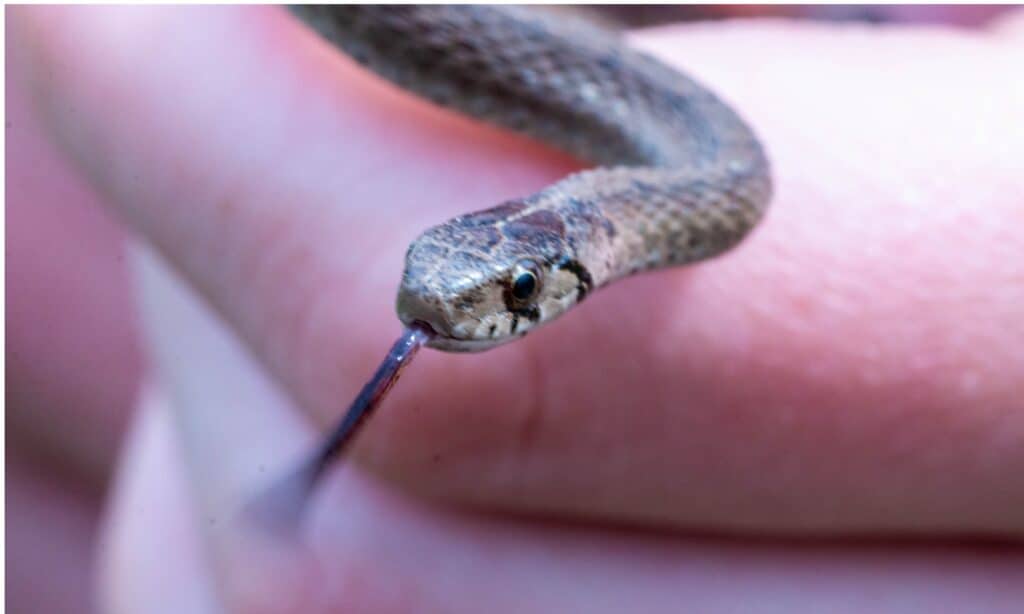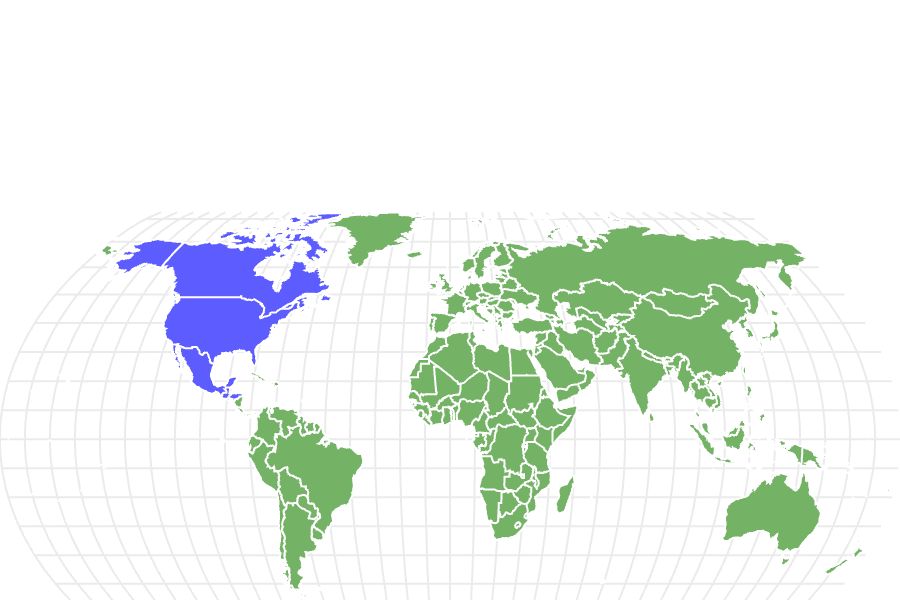De Kay’s Brown Snake
Storeria dekayi
They have specialized jaws for removing snails from shells.
Advertisement
De Kay’s Brown Snake Facts
- Prey
- Snails, slugs, earthworms, larvae
- Main Prey
- earthworms
- Group Behavior
- Solitary except during mating season
- Communal Dens
- Fun Fact
- They have specialized jaws for removing snails from shells.
- Biggest Threat
- Larger predators
- Most Distinctive Feature
- Light colored dorsal stripe and keeled scales
- Other Name(s)
- Brown snake
- Litter Size
- 2-20
- Lifestyle
- Diurnal
- or Nocturnal Depending on Region and Season
- Favorite Food
- Earthworms and slugs
De Kay’s Brown Snake Physical Characteristics
- Color
- Brown
- Grey
- Black
- White
- Skin Type
- Scales
- Lifespan
- 7 years in captivity
- Length
- Up to 12 inches
- Age of Sexual Maturity
- 2 years
- Venomous
- No
- Aggression
- Low
View all of the De Kay’s Brown Snake images!
De Kay’s brown snake is widespread across the eastern half of North America and Central America.
It’s nonvenomous and generally very docile but spends most of its time underground or in otherwise shady locations. This snail and slug-eating snake prefers moist areas near its favorite prey, where people often find them.
Incredible Facts
- Zoologist James Ellsworth De Kay (1792-1851) collected the first specimen on Long Island, New York.
- They eat a variety of soft-bodied creatures and have specialized jaws to remove snails from their shells.
- The longest De Kay’s brown snake recorded was just under 20 inches long, but most will never exceed 12 inches.
Scientific Name and Classification
De Kay’s brown snake’s scientific name is Storeria dekayi. It’s a nonvenomous member of the Colubridae family, like garter snakes and king snakes. The genus, Storeria, honors David Humphreys Storer, and its specific name honors James Ellsworth De Kay. This snake is the only one in North America whose binomial scientific name honors two people. De Kay’s brown snakes are also called brown snakes or American brown snakes.
Until 2018, there were seven subspecies, but they were too difficult to distinguish from one another by morphology or genetics.
Types of Brown Snake
De Kay’s brown snake is one of five species in the Storeria genus. They are all small and generally stay under 12 inches long, have keeled scales and a stripe running down the length of their back. Here are the others:
- Florida brown snake (Storeria victa)
- Florida redbelly snake (Storeria occipitomaculata)
- Mexican brown snake (Storeria storerioides)
- Mexican yellowbelly brown snake (Storeria hidalgoensis)
De Kay’s Brown Snake Appearance
De Kay’s brown snake is gray to brown with a lighter-colored dorsal stripe bordered by small black spots. Its body is long and thin with large-ish eyes with round pupils; many have a darker brown headstamp and may have stripes on its head. Unlike other snakes of its size, De Kay’s brown snake has keeled scales that give it a rough texture.
It’s a small snake that’s frequently mistaken for a juvenile of another species, like racers, garter snakes, or even rim rock crowned snakes. Adults are usually less than 12 inches long, from snout to tail, but the record was 19 3/8″ long.

De Kay’s brown snakes sometimes have stripes on the side of their head.
©iStock.com/mynewturtle
De Kay’s Brown Snake Behavior
This snake is harmless and very shy. Even though it’s reclusive, there are many sightings every year. Scientists believe this indicates a large population. It’s likely to hide or try to escape, but it may musk and leave your hands smelling awful. If it feels very threatened, De Kay’s brown snake might try to bite. The little snake might be able to pinch the webbing of your finger, and it’s small enough you may not even feel it.
Most of the time, they’re active during the day. However, they’ll switch to a nocturnal behavior pattern when the summer gets hot. This species is highly adaptable, which lends to its overall success.
De Kay’s brown snakes are most often seen after heavy rains or while heading to or from brumation locations. Brumation is the reptile version of hibernation. During the cooler months, the snake brumates in dens with other snakes to share warmth. Other species, such as smooth green snakes, garter snakes, and red-bellied snakes, also share dens with brown snakes.
De Kay’s Brown Snake Habitat and Diet
Dekay’s brown snake inhabits southern Ontario and Quebec, most of the eastern United States, Guatemala, Honduras, Mexico, and maybe El Salvador. It occurs in nearly all habitats in its range, which includes neighborhoods and cities. Its only requirement is a moist habitat with prey.
Even though this snake prefers damp living accommodations, it isn’t aquatic. People find it under logs, debris, and leaf litter, and it’s small enough to go unnoticed most of the time. Their adaptable nature allows them to move into neighborhoods and gardens where they eat snails, slugs, and larvae. Human-altered habitats aren’t a problem for these snakes.
It has specialized jaws that help it remove snails from their shells for easier swallowing. People often consider the snake a friend to gardeners because they eat snails and slugs, although it also eats earthworms. Some bigger specimens might eat small toads or frogs, but they’re not generally as interested in these.
De Kay’s Brown Snake Predators, Threats, Conservation, and Population
De Kay’s brown snake’s small size means that it falls prey to any number of larger animals. The world really is out to get you when you’re small enough to be on everyone’s menu. Birds, cats, dogs, larger snakes, toads, frogs, weasels, and many other predators are likely to take these snakes as prey.
This species is tolerant of a wide variety of habitats and appears to have a healthy population of more than 100,000. It’s abundant in many locations, sometimes with hundreds of sightings per acre. The 2012 IUCN assessment determined that De Kay’s brown snake has no significant threat and is probably stable in the wild.
De Kay’s Brown Snake Reproduction, Babies, and Lifespan
The females leave a pheromone trail that the males follow to find them. De Kay’s brown snake is ovoviviparous and gives birth to 2-20 babies in late July and early August. Essentially, instead of laying eggs, the females hold the eggs inside until the time when they would ordinarily hatch. It gives them a better chance of survival by not laying eggs that predators may eat.
When they’re born, they measure about 3 1/2 inches long. At this size, they’re easy to mistake for an earthworm themselves. Babies sometimes stay near their mothers for a few days before striking out on their own. This species reaches maturity in about two years. Scientists don’t know much about their lifespan in the wild; however, a captive snake lived for seven years. So, it’s possible that one in the wild could have a similar lifespan if it survived that long.
Similar Animals
View all 110 animals that start with DDe Kay’s Brown Snake FAQs (Frequently Asked Questions)
Where do De Kay's brown snakes live?
Their range is huge and extends from southeastern Canada down through most of the United States east of the Rockies, and into Central America.
How do De Kay's brown snakes hunt?
Like most snakes, they’re ambush predators. Yet, they hunt relatively slow prey and can slither up to it in most cases.
What do De Kay's brown snakes eat?
Mostly earthworms and other invertebrates.
Are De Kay's brown snake venomous?
No, and their mouths are so small that they’d have a hard time even biting a person defensively.
Thank you for reading! Have some feedback for us? Contact the AZ Animals editorial team.
Sources
- Hammerson, G.A., Mendoza-Quijano, F. & Lee, J. 2013. Storeria dekayi. The IUCN Red List of Threatened Species 2013: e.T63928A3131331. https://dx.doi.org/10.2305/IUCN.UK.2013-2.RLTS.T63928A3131331.en. Accessed on 12 September 2022., Available here: https://www.iucnredlist.org/species/63928/3131331
- Reptarium Reptile Database, Storeria dekayi, Available here: https://reptile-database.reptarium.cz/species?genus=Storeria&species=dekayi
- Agan, Justin 2013. Geographic Distribution: Storeria dekayi (Dekay's brownsnake). Herpetological Review 44 (4): 630, Available here: https://ssarherps.org/herpetological-review-pdfs/

















